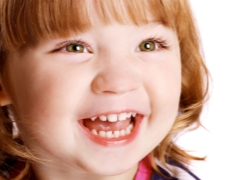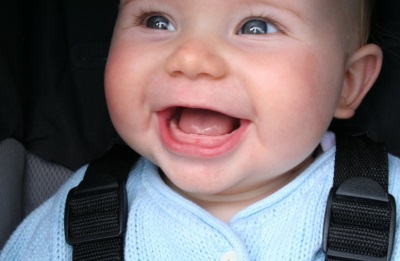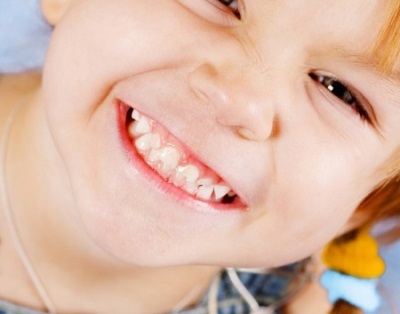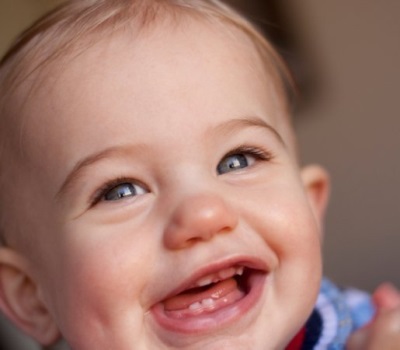How many baby teeth should children have?
Each mother is looking forward to the appearance of the first tooth of her baby and hopes that the crumb will avoid any problems that make it necessary to be treated by a dentist. And in order to understand whether everything is in order with teething, parents should know when the baby's teeth are normally cut in a child and how many should be at a certain age.
Why do baby teeth and their differences from permanent
Milk teeth appear in children of the first years of life for:
- Opportunities to bite off food. This function is performed by the front narrow teeth, called incisors.
- Thoroughly rubbing and chewing food. To do this, the child appears wider teeth, which are called molars.
- Proper development of chewing muscles.
- Participation in the normal development of speech.
- Formation of the basis of the correct bite. Baby teeth in the first 3-3.5 years are tight, and then the jaw grows, which leads to their separation and the appearance of gaps between the teeth. This is completely normal and should not bother parents.
The author of the following video will tell you why baby teeth are needed.
In total, the children “hatch” 20 teeth, which Hippocrates called milky, linking development and their shift with breast milk.
They differ from the teeth that are in adults, such features:
- Smaller crowns.
- More subtle enamel.
- Another color.
- Large volume of pulp.
- Shorter and wider roots that diverge to the sides.
How and when does the first tooth appear
The question of the appearance of the first tooth is of concern to almost all mothers, especially if the peers of the child with whom he communicates, he has already “hired”. The timing of the appearance is influenced by the individual characteristics of the baby, so you should not pay attention to other children and compare the baby with them.
For some of the babies, the first tooth will appear only in 8-9 months, and someone will please his mother by knocking on the spoon in 5 months or half a year. Earlier and later eruption occurs. And it depends primarily on heredity, but the nutrition of the crumbs and the presence of various diseases play a certain role.
The appearance of the first tooth of the mother can tell the state of the crumbs, as the kids usually do not tolerate this painful process. The gums at the site of appearance swells (there is a tooth bump), the baby's salivation increases. Due to the pressure on the gums, it gradually becomes thinner.
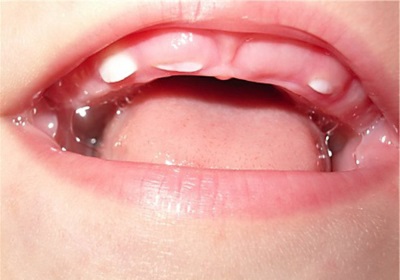
The tooth moves upwards, its root develops, the tissues under the tooth are rebuilt. When the crown is cut through the gum, it continues to grow until it is in a comfortable position in accordance with the adjacent teeth. In some children, they grow in different directions, but when the entire dentition is cut, they tend to grind and align.
Rules and teething scheme
Despite the fact that the terms of eruption on each infant will be individual, for most of the children the teeth appear in a specific order and at a certain age.
- At the age of 6-7 months, the central lower incisors, which are also called “ediniches”, erupt.
- At the age of 8 or 9 months, the child is added a pair of "units" and from above, after which, at 9-11 months of age, a pair of upper incisors, called "twos", join them on the sides.
- Approximately to a year (at the majority of children in 11-13 months) "two" and on the lower jaw are cut.
- Next comes the turn of the fours. So called the first molars, which appear in 12-15 months. First, the upper, and then the lower molars erupt.
- Babies 16-18 months begin to erupt fangs. These teeth, called for their arrangement "troika", appear first on the lower jaw, and then on the top.
- Starting at the age of 1 year and 8 months, second molars are also cut in children, which are also called “fives” or back molars. They complete the process of teething milk teeth.
Quantities norm
To navigate, whether everything is fine with teething at the toddler, parents should use the average data on the number, which appears in babies to a certain age. In most cases, doctors use the formula "age in months minus 4".
According to this formula, the first two teeth appear at 6 months of age, and all 20 can be observed in most children over the age of 24 months.
Here is a table with averaged measures of the number of teeth at a certain age of a child:
|
Age |
Number of teeth |
|
6-7 months |
2 - babies have lower incisors |
|
8-9 months |
4 - the child has 2 lower incisors, to which 2 upper incisors are added |
|
9-11 months |
6 - another 2 upper side cutters are added to the lower and upper central incisors |
|
11-13 months |
8 - another 2 lower side cutters are added to the central incisors at the top and bottom, as well as the upper lateral incisors |
|
12-15 months |
12 - in addition to the existing 8 incisors, the first molars erupt |
|
18-20 months |
16 - the child has all the incisors and 4 molars, as well as fangs |
|
20-30 months |
20 - the second molars erupt through the baby, that is, all the teeth have already appeared |
Teething problems
- Soreness in a child. To facilitate the condition of the baby, doctors advise using an anesthetic gel, as well as giving the baby a special chilled teether bite.
- Temperature rise. In some children, with the appearance of the next tooth, the fever can reach +38.5ºC. In such a situation, it is impossible to do without an antipyretic agent, which the doctor should recommend.
- Copious salivation. This phenomenon causes great discomfort in the child, especially if the baby wipes the saliva from the chin with a towel, which causes irritation and rash. If saliva enters the airway, it can provoke a cough. If an excess of saliva enters the crumbs stomach, it can lead to indigestion. Mom should wet the saliva with a napkin and treat the skin around the mouth with baby cream.
- Delay teething. Its causes may be a lack of calcium in the diet, metabolic disorders, rickets, vitamin deficiency or endocrine pathology. To determine why the teeth do not “rush” to appear, you should visit the dentist with the child and make an x-ray of the jaws. A visit to the doctor is indicated in the absence of at least one tooth by the year.
- Violation of the order of eruption. This may be due to the individual characteristics of the child or to be a manifestation of the absence of the rudiments of some teeth. To clarify the situation will help the dentist.
- The eruption of "extra" teeth. This situation occurs due to mutations and is manifested by the eruption of more than 20 milk teeth in children. The phenomenon is called polyodontia.
In the next water spot you can see how to help your child and ease the discomfort.
You will learn a lot of interesting information after seeing the transfer of Dr. Komarovsky.
